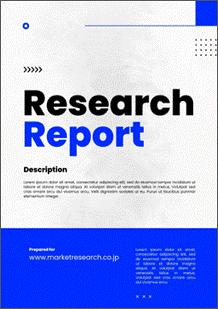 | • レポートコード:MRC2202A151 • 出版社/出版日:Mordor Intelligence / 2022年1月28日 • レポート形態:英文、PDF、100ページ • 納品方法:Eメール(受注後2-3営業日) • 産業分類:食品 |
| Single User | ¥703,000 (USD4,750) | ▷ お問い合わせ |
| Team User | ¥962,000 (USD6,500) | ▷ お問い合わせ |
| Corporate License | ¥1,295,000 (USD8,750) | ▷ お問い合わせ |
• お支払方法:銀行振込(納品後、ご請求書送付)
レポート概要
| Mordor Intelligence社は、世界の食品用アミノ酸市場規模が2019年から2024年まで、年平均6.23%成長すると予測しています。本調査レポートでは、食品用アミノ酸の世界市場について調査し、イントロダクション、調査手法、エグゼクティブサマリー、市場動向、用途別(ダイエットサプリメント、栄養飲料、RTE食品、アイスクリーム・デザート、その他)分析、地域別(北米、ヨーロッパ、アジア太平洋、南米、中東・アフリカ)分析、競争状況、市場機会・将来傾向などを掲載しています。 ・イントロダクション ・調査手法 ・エグゼクティブサマリー ・市場動向 ・世界の食品用アミノ酸市場規模:用途別(ダイエットサプリメント、栄養飲料、RTE食品、アイスクリーム・デザート、その他) ・世界の食品用アミノ酸市場規模:地域別(北米、ヨーロッパ、アジア太平洋、南米、中東・アフリカ) ・競争状況(Prinova Group LLC、Ajinomoto Co. Inc.、Merck KGaA、Daesang Corporation、Royal DSM、Brenntag AG、Kemin Industries、Novus International, Inc. (USA)、Sunitomo Chemical Co. Ltd、AMINO GMBH) ・市場機会・将来傾向 |
Global food amino acids market is projected to register a CAGR of 6.23% during the forecast period 2019-2024.
Key Highlights
- The increasing demand for amino acids as functional foods, coupled with the rising adoption of glutamic acid as a flavor enhancer in various foods and beverages, is likely to propel the growth of the market in the next few years.
- Additionally, the increase in demand for amino acids for various nutraceutical and dietary supplements, owing to the health benefits offered by amino acids, is expected to fuel the demand for amino acids during the review period.
- Thus, the wide range of application of amino acids, starting from flavor development, preservation, nutritional component/building block of protein to specialty ingredients, such as aspartame, is expected to drive the market.
Key Market Trends
Increasing Consumption of Dietary Supplements
Protein remains on the top position when it comes to dietary supplements; and amino acids are known to be building blocks of protein formation. Amino acids have been found to have multiple functional benefits in human nutrition. For example, glycine has been found to improve sleep quality; and leucine for its role in muscle protein synthesis, thus, contributing to longer and healthy life expectancy in the elderly population. The increase in international sporting events has also led to increased attention on the physiological effects of amino acids (BCAAs) on muscles, which is likely to offer a potential opportunity to amino acid ingredient manufacturers.
Asia-Pacific Holds the Major Share in Food Amino Acids
Asia-Pacific region holds the largest market share followed by North America. The increase in use of food amino acid as a flavor enhancer in the food industry and growth in concern for healthy diet among consumers are fueling the demand for food amino acids in the Asia-Pacific market. Major demand for food amino acids from the dietary supplement industry has been seen due to the growing trend of adding dietary supplements in consumer diet in this region. The major importers of food amino acids include China, Netherlands, Belgium, Indonesia and United States. Based on the increasing consumption of processed and convenience food, the import and export in the developed countries is found to raise at a steady growth rate.
Competitive Landscape
Global food amino acids market is moderately consolidated. It consists of the international key players and local manufacturers at different levels of the value chain. Some of the major key players in the market are Prinova Group LLC, Kemin Industries, Novus International, Inc. (USA), and Ajinomoto Co. Inc among others.
Additional Benefits:
- The market estimate (ME) sheet in Excel format
- 3 months of analyst support
1 INTRODUCTION
1.1 Study Deliverables
1.2 Study Assumptions
1.3 Scope of the Study
2 RESEARCH METHODOLOGY
3 EXECUTIVE SUMMARY
3.1 Market Overview
4 MARKET DYNAMICS
4.1 Market Drivers
4.2 Market Restraints
4.3 Porter’s Five Force Analysis
4.3.1 Threat of New Entrants
4.3.2 Bargaining Power of Buyers/Consumers
4.3.3 Bargaining Power of Suppliers
4.3.4 Threat of Substitute Products
4.3.5 Intensity of Competitive Rivalry
5 MARKET SEGMENTATION
5.1 By Application
5.1.1 Dietary Supplements
5.1.2 Nutritional Beverages
5.1.3 Ready-to-eat Food
5.1.4 Ice Cream and Dessert
5.1.5 Others
5.2 Geography
5.2.1 North America
5.2.1.1 United States
5.2.1.2 Canada
5.2.1.3 Mexico
5.2.1.4 Rest of North America
5.2.2 Europe
5.2.2.1 United Kingdom
5.2.2.2 Germany
5.2.2.3 France
5.2.2.4 Russia
5.2.2.5 Italy
5.2.2.6 Spain
5.2.2.7 Rest of Europe
5.2.3 Asia Pacific
5.2.3.1 India
5.2.3.2 China
5.2.3.3 Japan
5.2.3.4 Australia
5.2.3.5 Rest of Asia-Pacific
5.2.4 South America
5.2.4.1 Brazil
5.2.4.2 Argentina
5.2.4.3 Rest of South America
5.2.5 Middle East & Africa
5.2.5.1 UAE
5.2.5.2 South Africa
5.2.5.3 Rest of MEA
6 COMPETITIVE LANDSCAPE
6.1 Most Active Companies
6.2 Most Adopted Strategies
6.3 Market Share Analysis
6.4 Company Profiles
6.4.1 Prinova Group LLC
6.4.2 Ajinomoto Co. Inc.
6.4.3 Merck KGaA
6.4.4 Daesang Corporation
6.4.5 Royal DSM
6.4.6 Brenntag AG
6.4.7 Kemin Industries
6.4.8 Novus International, Inc. (USA)
6.4.9 Sunitomo Chemical Co. Ltd
6.4.10 AMINO GMBH
7 MARKET OPPORTUNITIES AND FUTURE TRENDS